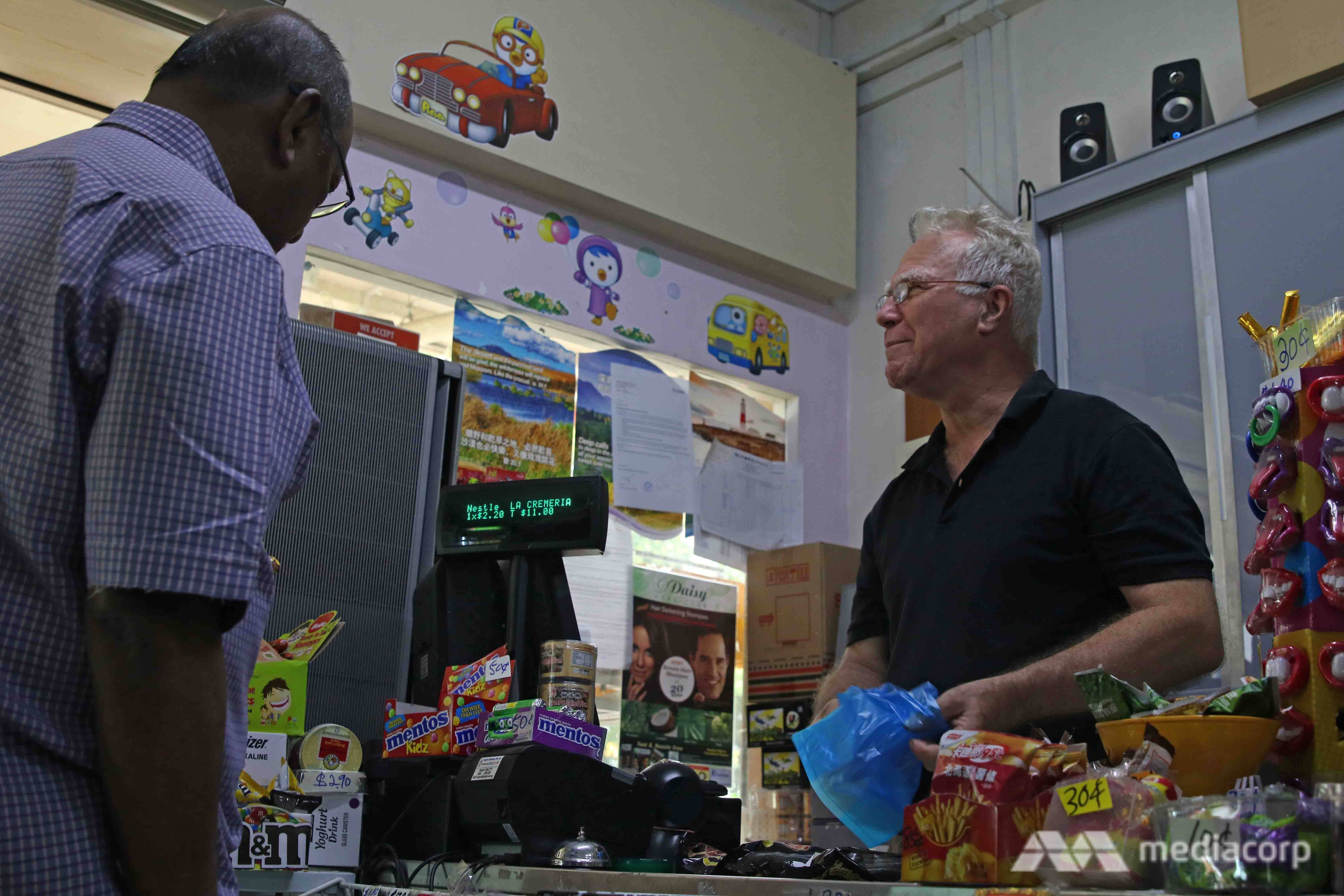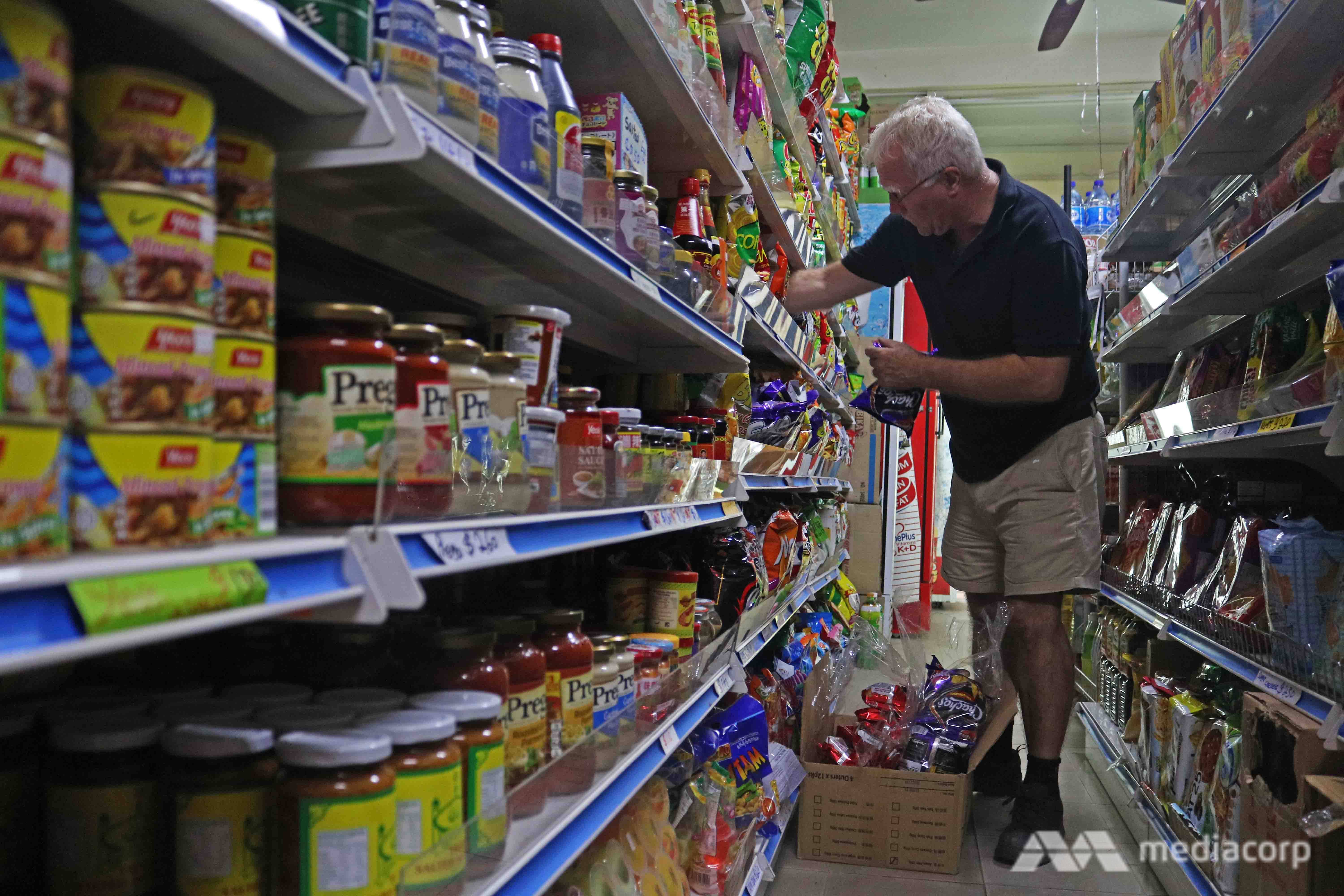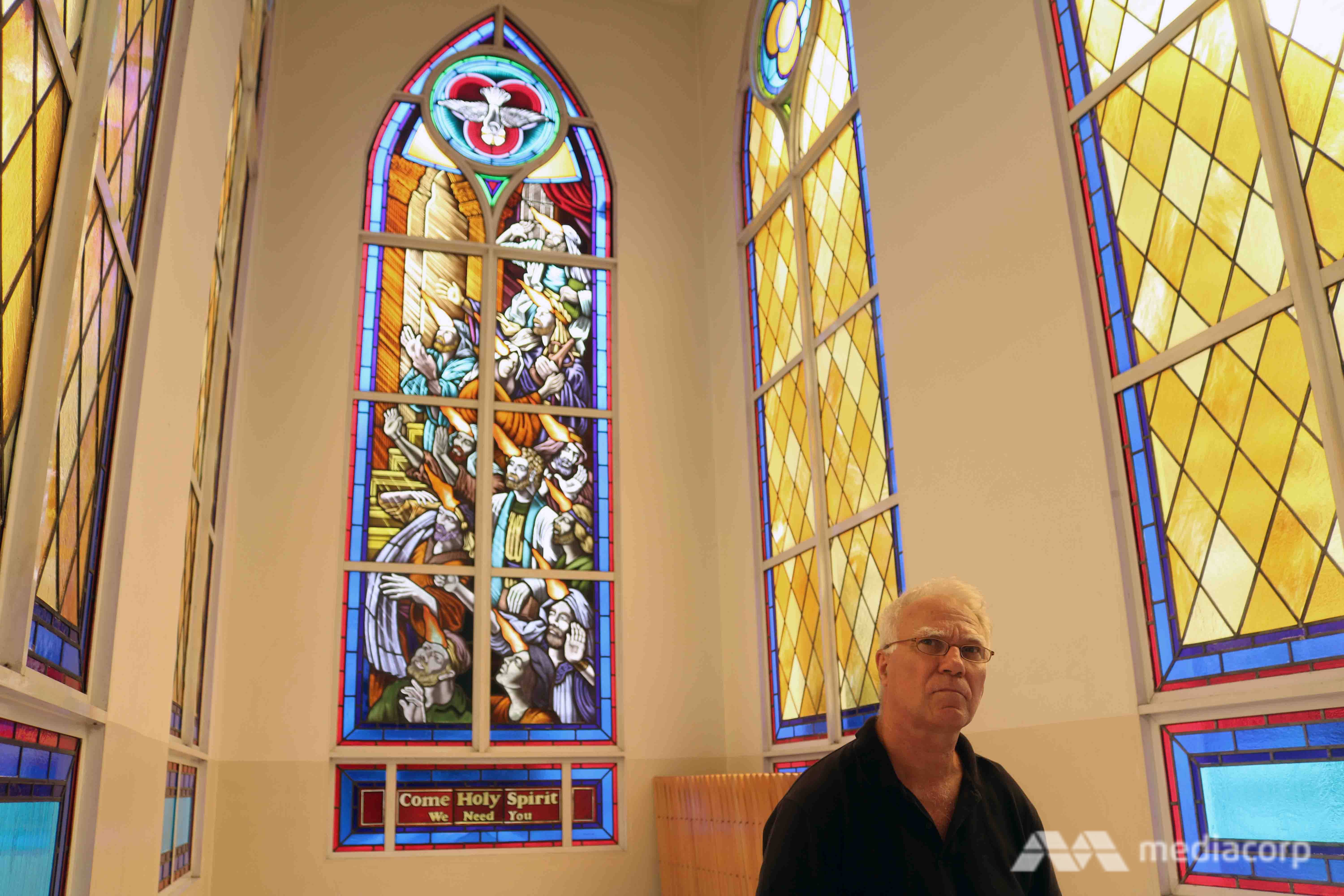SINGAPORE: Deep in the heart of Chai Chee, Runda Minimart is everything you’d expect of a heartland provision shop.
The storefront at Block 21, Chai Chee Road is packed with shelves of bread, eggs and children’s toys. Then there’s the customary row of colourful gashapon machines.
But walk inside and there is an unexpected sight: A silver-haired Caucasian manning the cash register. Australian Peter Brown, 62, has worked as a cashier in the shop since it first opened three years ago.
“Several people come in and go: ‘Ang moh in a shop? In Singapore? It’s not possible!’” he told Channel NewsAsia after completing a shift. “Then they ask if it’s my business. They think all ang mohs are bosses, not workers.”
The Permanent Resident, who has lived in Singapore for 24 years, is not your typical expatriate. He earns S$1,000 a month working four-hour shifts, seven days a week. Home is a rented room in an HDB flat a short walk away.
Peter has been around for so long that he’s become a familiar face in the neighbourhood. Even the fruit seller waves and shouts “ang moh” each time he walks by.

Peter dealing with customers. (Photo: Aqil Haziq Mahmud)
Some customers do not register Peter’s race, and automatically speak to him in Mandarin. He has picked up the language over time, although he is still far from fluent.
So, when he replies to customers, they often look up in shock before asking where he is from. “From China,” he usually says. “I play games with them.”
But Peter’s job is far from being just a game.
On top of his cashiering duties, he takes stock of sometimes challenging deliveries. “There are hundreds of different items and I’ve got to get them on the shelves or stored away because they block the aisles,” he said.
Peter also ensures the racks and fridges are constantly full. This means moving around a lot and topping up the bestselling Carlsberg cans as soon as they fly off the shelves.

Peter restocking the shelves. (Photo: Aqil Haziq Mahmud)
“Some days are dull, some days are very busy,” he said. “It’s not my idea of a career. I’m doing it because I can’t find anything else.”
THE ARTIST
It’s Friday morning at the shop and business has been slow all week. Then, a man pulls up with a trolley loaded with boxes of chips and cookies. Suddenly it’s not so slow.
Peter leaves his post and pulls the inventory list close to his nose – something doesn’t seem right. A line starts forming at the cashier and a boy impatiently rings the bell on the counter.
This is Peter’s world.
A woman walks past the shop front. (Photo: Aqil Haziq Mahmud)
To understand how this elderly man ended up working in a cramped shop almost 5,000km away from home, you have to go back more than two decades to when he landed his first job in Singapore at an American firm based in Bukit Timah.
Peter, a stained glass artist, had just come off a failed business venture in Australia. He was also hit with a fine after his previous employer ran into some legal problems.
“I needed to find some money urgently,” he said. “This company was offering me a good wage and immediate work, and I jumped at the opportunity.”
In 1993, the then 38-year-old left for Singapore to embark on a six-month contract painting windows for Hard Rock Cafes in the region.
The company had to look as far as Australia because glass painters were a “rare breed”. Furthermore, Peter said, it felt American artists would struggle with the culture shock of living and working in a place like Singapore.
It didn’t take long for Peter to experience the shock for himself.
“Here in Singapore, clients would spend six months debating how much to pay, and as soon as they agree the cost, they want the thing tomorrow,” he said. “My boss was constantly on my back, asking me to work faster and more efficiently.”
Outside of the “punishing schedules” at the office, Peter grappled with the unfamiliar cuisine. He described mee rebus as ingredients “floating around in this dark gravy”, while the smell of shrimp sauce in rojak “made me want to vomit”.
The weather was also too hot, and he did not understand a word of the local slang. “I remember going into the lift at work,” he said. “These girls were talking and I asked my colleague what language they were speaking. English? You’re kidding!”
Over the years, Peter got used to things. He learnt to love rojak and eventually spoke perfect Singlish. As for his job, the American company “kept getting work and they kept needing me”. The six-month contract became 12, then 18.
It wasn’t all good news, though.
The company started losing money and eventually fired him in 1995 after an argument. “I was in a low state of mind because I had lost my job, and I didn’t know whether I would stay here or go back to Australia,” he said.
THE CHURCH-GOER
Back at the shop, Peter usually takes the morning shift, which runs from 8am till noon. He raises the shutters, pushes out the roller shelves and counts the cigarette cartons in the cabinet behind the counter. This is a daily routine.
Cigarettes are one of the shop’s most popular items, Peter said before attending to a customer. He plucked out a pack of Winston Reds and pushed it across the counter.
Peter’s final assignment at the American company was to paint some windows for Bethesda Cathedral, a large church in Chai Chee. He completed the painting, but got sacked before it went up.

Peter with one of his pieces in the church. (Photo: Aqil Haziq Mahmud)
Just before Christmas that year, Peter turned up at the church with his camera as he always made it a habit to photograph his work for his portfolio.
“They were having a Christmas barbeque,” he said. “They were curious and didn’t know who I was, and they invited me to a church service.”
Peter identified as Christian at that time, but he wasn’t particularly pious. Even so, he found himself warming to the church’s messages.
He started attending church every week and eventually taught children at the Sunday school there. He also began teaching kids art and craft on Saturday evenings.
Peter explaining some of the finer details of glass painting. (Photo: Aqil Haziq Mahmud)
Peter also found a job at a local stained glass company, where he designed pieces for churches, hotels and condominiums. His proudest work? For a private home in Kuala Lumpur, he painted Da Vinci’s The Last Supper on a 3m by 2m window.
Peter admitted that he has grown comfortable in Singapore. “It was just a job,” he said of his first stint with the American company. “My plan was to come here, earn money and go home.”
More than a year after he left the glass company in 2012, a couple of church members opened the provision shop in Chai Chee and hired him as its cashier.
“I never dreamt that I would stay in Singapore for so long,” he said.
THE NOMAD
During his years here, Peter has lived in more than 10 homes, in locations ranging from Queenstown to Bedok North. He’s had to move around a lot because rental fees are “crazy”. “Everybody is selling their units,” he said.
He hates the constant shifting, but it has meant he has been able to explore different parts of Singapore. Because he loves the beach, he is particularly fond of Sentosa. And after moving to the east, he would regularly cycle along East Coast Park, which he called “one of Singapore’s great little places”.
Despite that, Peter said he’s not a very social person. Besides attending gatherings with church members on Friday evenings, he keeps very much to himself.
Peter checking the cigarettes. (Photo: Aqil Haziq Mahmud)
Still, he makes it a point to see his two brothers and a sister in Australia once a year. He goes to Bathurst, a small town three hours away by car from Sydney, where he grew up on a “beautiful” farm with his parents. His father died last July, his mother four years ago.
He also misses Australia’s seasons, vast spaces and Western food, which he stressed is more than “french fries, coleslaw and baked beans”.
Does he feel lonely in Singapore? “All the time, but you get used to it,” he replied. “Being alone is part of life. You don’t really make friends, but you chit-chat with customers.”
Peter said he’s been through a number of relationships here, but “nothing’s happened”. “I thought that I would like to get married. I thought I’d be a successful artist anywhere I go,” he said. “That’s a bit of a frustration for me.”
At his age, Peter acknowledged that the “book is closing fast, but I don’t know where it leads”.
“I’ve seen so many people here in Singapore in their 70s who are struggling to walk and don’t work,” he added. “In 10 years’ time, am I going to be sick?”
Peter keeps fit by visiting a gym in Chai Chee twice a week. He used to play tennis too, but his age has put the brakes on that. “Thankfully, my father and mother lived to 95 and 93, so maybe there’s good genes in the family,” he said with a laugh.
He’s also earning some extra cash by giving English tuition and working part-time with the same local glass company. This is so he can cover his S$600 a month rent and expenses like his phone bill and annual trip home.
Peter doesn’t want to retire because he can’t afford it. But things might change. With the inheritance from his late parents, he could buy his own house, be it in Singapore or Australia. It’s something he’s never had in his life.
Nevertheless, Peter described himself as the “biggest procrastinator in the world”. “When I get older, I won’t be able to work hard and my income goes down, so where do I spend my old age?” he said. “I avoid making decisions at all costs.”
Peter’s work schedule at the shop. (Photo: Aqil Haziq Mahmud)
He always found himself sticking around in Singapore because “there’s always work here to do”. He has great affection for the church too. “For some strange reason, it’s a good church.”
For Peter, life had not turned out how he thought it would, but he learnt not to “worry about what you think you’re lacking”.
“Life has its way of leading you to places, and it’s not your plan,” he said.




